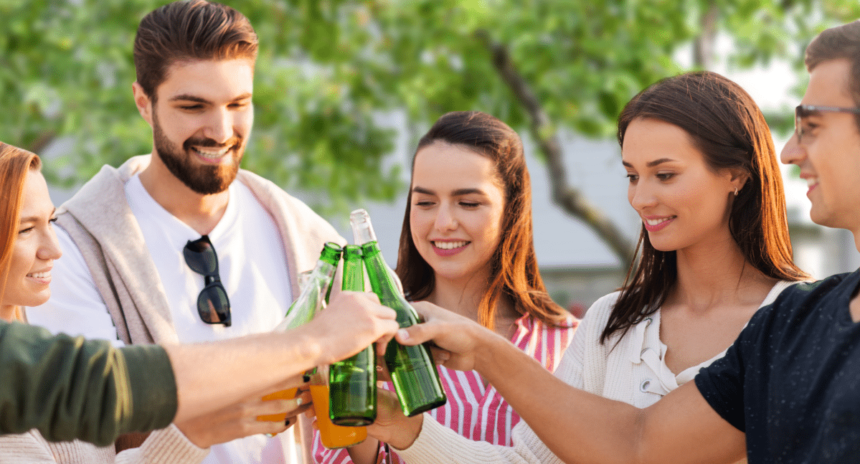In our fast-paced world, our daily rituals often revolve around our morning cup of coffee to rev up, and a relaxing 5 o’clock libation to wind down. However, as the health and wellness movement continue to gain momentum, we are witnessing a surge in functional beverages and zero proof options that aim to replace our indulgent choices without sacrificing taste, ambiance, and that precious emotional pause button.
These innovative products are designed to not only fit seamlessly into our daily routines but also enhance our emotional and physical well-being. In this article, we’ll explore how these healthier beverage choices fit within existing routines, while making a positive impact on our health.
Transformation in a Glass
The COVID-19 pandemic brought about a surge in alcohol consumption among those seeking solace from the uncertainties of the times. This habit was fed by the desire for a mental health break, but for many, its companionship morphed into a mental health ache. However, in the post-pandemic era, there is a noticeable shift towards healthier alternatives, particularly mocktails, alcohol-free offerings, and functional beverages that promise to induce mood-boosting benefits without the negative effects of alcohol.
Functional Beverages Earn a Seat at Happy Hour
This emerging trend offers an opportunity for national and niche brands to expand their consumer base by attracting those seeking alcohol-free alternatives with the calming attributes delivered by their evening libations. Nootropics, a cognitive enhancer, and adaptogens derived from plants, tea, and mushrooms, are gaining attention and popularity due to their potential to reduce anxiety, balance moods, and promote relaxation. These natural ingredients are finding their way into a variety of mocktails offering a refreshing, “floaty” and relaxing experience with the functional promise of delivering decompression sans alcohol.
This trend has also breathed new life into well-known minerals like magnesium, which is being repositioned to target stress relief and alleviate PMS symptoms. With the added convenience of various formats such as portable tinctures, powders, and ready-to-drink (RTD) beverages, it is easier than ever for everyone to incorporate this healthy alternative into their daily regimen.

Dry Bar: Sober and Sober Curious
O’Doul’s longstanding heritage in the non-alcoholic (e.g., NA) category is facing growing competition. Spanning wine, beer and even spirits, brands are beginning to recognize the growing demand for zero proof alternatives. The non-alcoholic landscape is accelerating with even mainstream brands like Corona, Heineken, Sam Adams, Budweiser, and Stella Rosa expanding their portfolio to include NA extensions. With intrinsic links to alcohol, how can established brands leverage their visual assets, imagery and brand equities while delivering such a contradicting unique point of difference—0.0%? It is a delicate balance, but possible.
The Opportunity
The growing sober and sober curious movement presents low hanging fruit for brands both big and small to grow their franchise. This can be accomplished not only by attracting NA purists, but also meeting the evolving needs of their loyal consumer base—the sober curious.
The Risk
For brands rooted in the alcohol space, diving into the alcohol-free arena when your heritage is alcohol-based, and your product lives in the alcohol section at retail presents unique challenges. If the changes are insufficient, this could result in a mistaken purchase, leading to disappointment, potential alienation, and risky mental health triggers. Therefore, it is crucial for brands to deliver the no alcohol positioning in a clear, effective way to avoid consumer confusion and build your brand. This holds true for the primary and secondary packaging.
In today’s landscape:
- Claims: Brands today are leveraging prominent packaging claims and messaging to communicate their unique proposition and benefits to consumers. Most often, explicitly stating “Non-Alcoholic”, “0%” or “0.0%” and/or explicitly highlighting reasons-to-believe it will deliver on its functional promise (e.g., adaptogens).
- Violators: Contrasting colors and unique holding devices are often employed to call attention to the key message.
The Watchouts
- Protect Visual Intrusion and Brand Recognition at Shelf: Leverage existing visual equities to ensure visibility and recognition are retained for maximum brand blocking potential. Unsure of what you own? Find out before
- Prevent Mistaken Purchases and Selections: Clearly designating the alcohol-free unique point of difference on pack is non-negotiable. Get it wrong, and it could leave a bad taste in the shopper’s mouth regardless of the alcohol spectrum they sit on. Purchasing the wrong product could provoke alienation, a potent risk in the zero-proof category. This is equally important for those in the service industry crafting or fetching the NA option for a customer. The in-home needs also cannot be overlooked, especially when contrasting alcohol desires co-exist.
- Taste: Either in the form of reassurance or elevation, the taste experience can make or break this new relationship with your consumer. Your existing consumers may seek taste reassurance that mimics the past when the presence of alcohol existed. To others, taste is a crucial part of the unwind experience—whether it’s simply flavor, or revisiting the tartness of wine, earthy hops, sweet umbrella drinks or spicy spirits—taste is important.
- Experiential: Whether it’s reminiscent of the past, or a new, visually arresting aesthetic via unique finishes and textures, the visual look and feel contributes to the unwind experience. From purchasing to reflecting with your alcohol-free libation in hand, the look and feel of the pack adorns that pause button moment.
Too Far or Not Far Enough?
What is a brand to do? Go safe and evolutionary, or aggressive and revolutionary? Well, the answer depends on how entrenched the brand is in the category. If the brand has longevity and stature, you may want to play it safe. If you’re a small or new player, there could be more latitude to take risks and standout. Here are a few strategies to ponder:
- Entrenched in the category? Determine what your design parameters and opportunities are to protect your visual assets, while setting yourself apart from competition and its sibling with entrenched roots in alcohol.
- New player? Low brand awareness can be an obstacle, but also an advantage, especially when consumers are proactively seeking out healthy alternatives to their decadent loyalties. Immerse yourself in your consumer, explore the category landscape to uncover category codes, boundaries, and white spaces. It is equally important to balance category codes with carving out an ownable identity to foster overtime.
- Hero the unique point of difference to promote its distinctive identity.
- Keep in mind, messaging might not be enough.
- Explore ways to generate excitement, spark relevancy, and inspire curiosity. Retain or elevate the consumption experience via whimsical branding, engaging graphics, structural enhancements, unique materials, reflective finishes, or textures.
What’s Next?
As everyone prioritizes their health and well-being, the beverage industry is responding with a wave of functional products and healthier alternatives aimed at enhancing daily routines, physical and mental well-being. From matcha and mushroom coffee for an energizing morning boost to mocktails infused with adaptogens for a calming evening wind-down, these options are transforming the way we think about our staple AM/PM choices.
For brands in the health and well-being space, this trend represents both an opportunity and a challenge. Investing in market research and effective packaging design is essential to guide consumer recognition and communicate the positioning clearly. By doing so, these brands can continue to drive the evolution of functional beverages and empower consumers to make healthier choices that contribute to their overall well-being.
Discover more by visiting www.behaviorally.com today.








